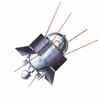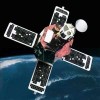
Home - Search - Browse - Alphabetic Index: 0- 1- 2- 3- 4- 5- 6- 7- 8- 9
A- B- C- D- E- F- G- H- I- J- K- L- M- N- O- P- Q- R- S- T- U- V- W- X- Y- Z
Solar
Category of spacecraft.
Subtopics
 |
Pioneer 5 American solar satellite. Pioneer 5 was designed to provide the first map of the interplanetary magnetic field. The vehicle functioned for a record 106 days, and communicated with Earth from a record distance of 36.2 million km. |
 |
P-14 American solar satellite. Magnetic field data. Research satellite built by NASA, Goddard Space Flight Center for NASA, USA. Launched 1961. |
 |
S-15 Astronomy, Gamma ray satellite built by Marshall Space Flight Center for NASA, USA. Launched 1961. |
 |
EPE American solar satellite. Radiation and solar wind data. Research satellite operated by NASA, USA. Launched 1961 - 1964. |
 |
OSO American solar satellite. The Orbiting Solar Observatories, developed for NASA's Goddard Space Flight Center, were designed primarily as stabilized platforms for solar-oriented scientific instruments. Solar observatory satellite built by Ball Aerospace for NASA, USA. Launched 1962 - 1969. |
 |
GEOS American solar satellite. The GEOS spacecraft were gravity-gradient-stabilized, solar-cell powered satellites designed exclusively for geodetic studies. Research satellite operated by NASA, USA. Launched 1965 - 1968. |
 |
IQSY American solar satellite. Explorer 30. Solar radiation data. |
 |
Pioneer 6-7-8-9-E American solar satellite. Pioneers 6, 7, 8, and 9 were created to make the first detailed, comprehensive measurements of the solar wind, solar magnetic field and cosmic rays. Solar lander built by TRW for NASA, USA. Launched 1965 - 1969. |
 |
DS-U3-S Ukrainian solar satellite. Specialized orbital solar observatory for measuring solar rays in multiple spectral zones. Astronomy, solar satellite built by Yuzhnoye, Russia. Launched 1967 - 1968. |
 |
Solrad American series of satellites sponsored by the US Navy in a program to continuously monitor the Sun. SOLRAD was Satellite Techniques' first major project and NRL's first post-Vanguard satellite. |
 |
DS-U2-GF Ukrainian solar satellite. Cosmos 262. Conducted heliophysical studies. Astronomy, Solar satellite built by Yuzhnoye, Russia. Launched 1968. Used DS Bus. |
 |
SAS Series of American solar orbiting satellites for x-ray and gamma astronomy. |
 |
Hawkeye American solar satellite. Explorer 52. Solar wind experiments. Follow-on to Injun. |
 |
Helios German solar satellite. Solar probe. Launched by the United States and the Federal Republic of Germany. Heliocentric orbit 190 days, 0.309 x 0.985 AU x 0 deg. Solar lander built by Messerschmitt-B�lkow-Blohm (MBB) for NASA / BMF, Germany. Launched 1974 - 1976. |
 |
SMM American solar satellite. The Solar Maximum Mission (SMM) was intended primarily to study solar flares and related phenomena. Solar observatory satellite built by Fairchild for NASA, USA. Launched 1980. Used the MMS bus. |
 |
SME American solar satellite. The Solar Mesosphere Explorer satellite was developed to investigate the processes that create and destroy ozone in the Earth's upper atmosphere. Research satellite built by Ball Aerospace for NASA, USA. Launched 1981. |
 |
Spartan American solar satellite. The Spartan series consists of low-cost, Shuttle-launched, short-duration, sounding-rocket-type payloads. The payloads were retrievable and reusable with a turnaround time of 6 to 9 months. Spartan operated as an autonomous sub-satellite, and the data was stored on an internal tape recorder. Pointing and stabilization were achieved by an attitude control system capable of three-axis stabilized pointing to any target within +/- 3 arc-minutes. Shuttle retrievable satellite operated by NASA Goddard, USA. Launched 1985. |
 |
Ulysses European solar satellite. Ulysses was a joint NASA / ESA mission designed to study the polar regions of the Sun. Solar lander built by Dornier (prime) for ESA, NASA, Europe. Launched 1990. |
 |
SOHO European solar satellite. SOHO was a component of the Collaborative Solar-Terrestrial Research (COSTR) Program of the International Solar Terrestrial Physics (ISTP) Program. Solar Observatory satellite built by Matra Marconi Space for ESA, NASA, Europe. Launched 1995. |
 |
SAC-B Argentinian solar satellite. SAC-B, an Argentine / US mission, was designed to study solar physics and astrophysics through the examination of solar flares, gamma-ray burst sources and the diffuse soft X-ray cosmic background. Scientific satellite built by INVAP for CONAE, Argentina. Launched 1996. |
 |
ACE American solar satellite. Research satellite built by Johns Hopkins University Applied Physics Laboratory (APL) for NASA, USA. Launched 1997. |
 |
TRACE American solar satellite. TRACE, carried a 30-cm extreme ultraviolet imaging telescope for studies of the sun. Lockheed was the lead contractor while the Smithsonian Astrophysical Observatory made the telescope mirrors. Solar observatory satellite built by NASA Goddard Space Flight Center for NASA, USA. Launched 1998. |
 |
SST Chinese solar satellite. Study 1998. The SST, an advanced Chinese solar telescope, was to have been part of a sun monitoring system built along the earth's meridian circle at 120 degrees east. |
 |
ACRIMSAT American solar satellite. The NASA ACRIMSAT satellite was managed by JPL, and measured the integrated solar energy output from 0.2 to 2 microns. ACRIMSAT was built by Orbital Sciences. Solar observing satellite built by Orbital Sciences Corporation (OSC) for NASA, USA. Launched 1999. Used the MiniStar bus. |
 |
IMAGE American solar satellite. The IMAGE spacecraft imaged remote particle populations in the magnetosphere. Research satellite built by Lockheed Martin Missiles & Space (Sunnyvale) for NASA, USA. Launched 2000. |
 |
Genesis American solar satellite. Genesis was part of NASA's Discovery program. Its objective was to fly to the Earth-Sun L1 point and spend two years collecting samples of the solar wind. Solar wind sample return satellite built by Lockheed Martin Astronautics for NASA, USA. Launched 2001. |
 |
TIMED American solar satellite. TIMED was the first NASA Solar Terrestrial Probe, operated by Johns Hopkins Applied Physics Lab to study the thermosphere, mesosphere and lower ionosphere. Science, Atmosphere satellite built by Johns Hopkins University Applied Physics Laboratory (APL) for NASA, USA. Launched 2001. |
 |
HESSI American solar satellite. HESSI, the sixth Small Explorer, was a Spectrum Astro satellite derived from the SA-200S design. It carried a rotating modulation collimator transform telescope. Solar observatory satellite built by Spectrum Astro for NASA, USA. Launched 2002. Used the SA-200B (modified), spin stabilized bus. |
 |
SORCE American solar satellite. Earth science satellite built by Orbital Sciences Corporation (OSC) for NASA, USA. Launched 2003. Used the LEOStar-2 bus. |
 |
Stereo American solar satellite. Two launched on 2006.10.26 (Stereo Ahead) and (Stereo Behind). Built by Johns Hopkins University Applied Physics Laboratory (APL) for NASA, USA. Launched 2006. |
Family: Astronomy. Country: Japan. Engines: RS-77. Launch Sites: Kagoshima M.
Back to top of page
Home - Search - Browse - Alphabetic Index: 0- 1- 2- 3- 4- 5- 6- 7- 8- 9
A- B- C- D- E- F- G- H- I- J- K- L- M- N- O- P- Q- R- S- T- U- V- W- X- Y- Z
© 1997-2019 Mark Wade - Contact
© / Conditions for Use
